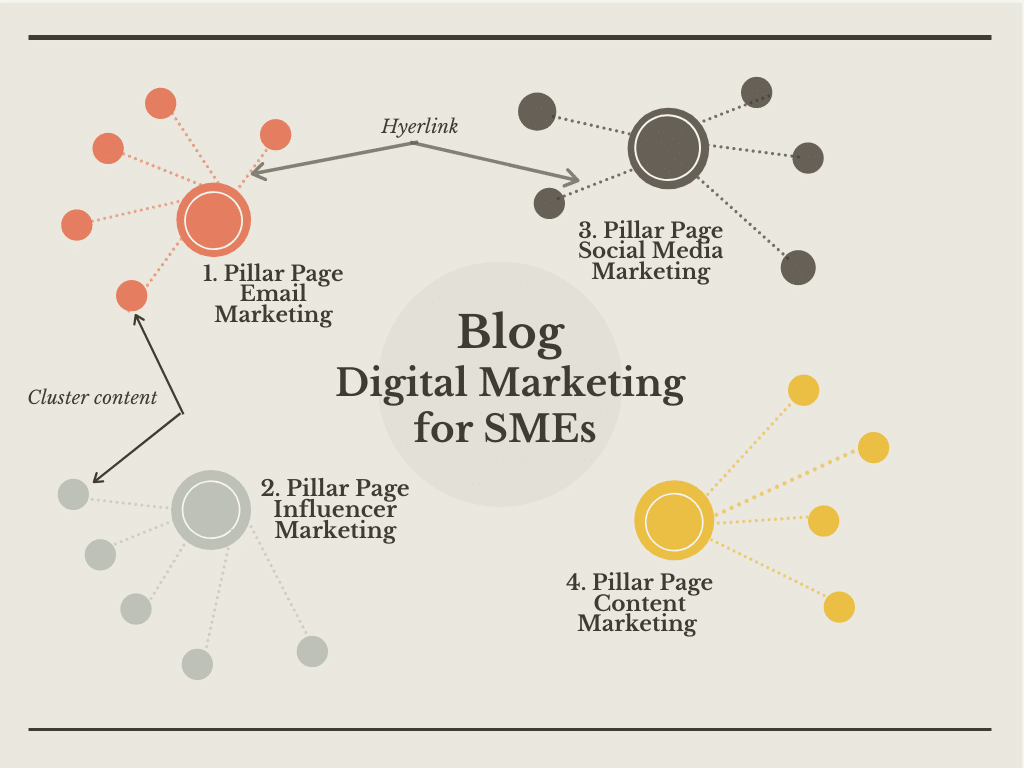Introduction
Since content became the primary battleground,
SEO experts and content managers have been continuously working to increase their search engine rank and rating. A website that fails to appear in the top results in their target customer's search has no chances of success. And so, experts work continuously to incorporate the most effective techniques to boost their site's visibility.
Previously, keywords were the focus of an SEO strategy, while their importance is not lost; lately, SEO experts are emphasizing on topic clusters to achieve optimization. Topic Clusters or the Topic Cluster Model is a relatively new technique in which content is created in a group of related pieces that each link back to a single central topic.
At its essence, the Topic Cluster Model is an SEO strategy that focuses on topics instead of keywords to improve site architecture by making it easier for web crawlers to find related content and ultimately increase your website's ranking.
In this article, we are going to discuss the Topic Cluster model, its benefits, and how you can use create topic clusters to boost your website. Let's get started.
What are Topic Clusters?
To understand this model, we have to discuss your
content strategy. Right now, how do you decide which topics you are going to write? I don't know about you, but most content creators follow one of two popular strategies: they either develop a long list of topics beforehand and then work their way through the list over time, or they think of ideas as they go.
In both strategies, content creators target variations of long-tail keywords for the same topic, which ultimately means that you end up publishing multiple articles on the same topic, each targeting a specific long-tail keyword. Although effective, this strategy clutters your website and makes it repetitive. Furthermore, it fails to use the content you publish effectively.
Enter the
Topic Cluster Model; in this model, content creators divide their content areas in a single broad topic, also called pillar, which provides a broad overview of the topic. Linked to the pillar are multiple cluster pages that each focus on addressing specific keywords. All of these cluster pages are related to the main topic, and they are linked to the pillar page with the same hyperlink anchor text.

Therefore, when even one page performs well, the entire cluster increases in the ranking. The other benefit of this strategy is that the semantic relationship between the cluster pages and the pillar pages signals to google that this website is a trusted authority on this topic. Writing multiple long-form articles on the same topic that are linked to each other means that you are a credible source and not just an amateur blog.
That is just what Google needs to know to push you to the top spot in search results. When it knows that you are posting useful content that is valuable to your reader, you are going to be bumped to the first page for sure.
The Benefits of Cluster Topics
If you are still unconvinced of its benefits, take a look at the following benefits of Clustering topics:
1. Time Efficient
In the Cluster Topic Model, the content creator is producing related articles on the same topic. So essentially, you are producing multiple content pieces while doing research only once. With Topic clusters, you end up writing 7 or more pieces in the time it takes you to write one article!
What is more, as you continue to write related content on the topic, you become more and more familiar with it, and hence your writing speed and quality increase.
2. Establishes Credibility
When you publish good quality content on multiple aspects of the same topic, you tell the world that you are a leading source of information in this field. Publishing one article on a subject does not make you an expert, but when you post multiple topics, it highlights your interest, understanding, and command over the topic.
3. Improves SEO
We cannot stress this enough, a Topic Cluster model improves your SEO so much so that your Google ranks your site. If implemented correctly, the Topic Clustering strategy is instrumental in giving websites a boost.
4. Increases Reach
You increase your chances of reaching more people when you publish multiple articles with a specific long-tail keyword each. Your target audience may search for a piece of particular information by using a thousand different long-tail keywords. Therefore, writing multiple articles that are linked to the pillar page makes sure that your reader can access you no matter which search-terms they use.
Think of the cluster pages as paths or freeways to a building. Each road brings in traffic from a different area of town. Logically, a building that is reachable from multiple points is likely to get more visitors. Similarly, if you had multiple paths to the content, you will increase the chances that more people are going to read it.
What Does This Mean for Your Website?
Many among you might be thinking that Topic Clusters are redundant; when a website's blog starts posting content, they ultimately do create a group of somewhat related content, albeit unconsciously. So what's the fuss about Topic Clusters?
The thing is that when you produce content without categorizing it in clusters beforehand, you end publishing contents that are similar to each other. Both these contents compete with each other for viewership. You can say its
cannibalism; one content on your site ends up devouring the viewership of its sibling content because they are both too similar to each other.
Even worse, these similar contents confuse search engine web crawlers that are continuously looking for pages to rank. Instead of supporting each other, these pages end up competing with each other to be found by the search engine.
On the other hand, when you use Topic Clusters, you are presenting a more organized and orderly outlook to web crawlers, informing them on which page to prioritize. Furthermore, since all cluster pages are linked to the pillar page, ranking one page boosts the other automatically as well. This is not possible in the old, disjointed content strategy.
The Takeaway? When you use the Topic Cluster Strategy, your website will rank higher on Search Engine Result Page (SERP), and your website traffic will increase.
How to Create Topic Clusters
Afraid that you will need to write new content if you shift to this new strategy? Absolutely not! Creating Topic Clusters is as simple as 123. Follow the following steps to rearrange existing content as per the new style. Here is how you do it:
Step 1: Organize Content by Topic Focus
The first you need to do is sort your existing content under broad topics. For example, let's say that your website produces content on
Digital Marketing. Therefore, you would already have published content that relates to several broad topics such as
Social Media Marketing, B2B Digital Marketing, SEO, Content Marketing, Video Marketing and so on.
Step 2: Create a Pillar Page and Interlink
Once you have categorized your content under each category, decide if you need a pillar page. Remember that a pillar page contains a general overview of the topic and that all pages are linked to the pillar page.
For instance, a pillar page on Social Media Marketing would discuss the concept broadly and highlight its different types, tools, and tactics. Similarly, it would link to cluster pages that would each explain a different face of Social Media Marketing such as Paid Facebook Ads, Affiliate Marketing, Influencer Marketing,
Social Media Marketing Analytics, and so on.
When sorting your content topically, remember that the crux of this strategy is to write about topics that you want your business to compete in. For instance, if you are posting about
Digital Marketing, you must think of topics that you want to write about that will establish you as a leading source for Digital Marketing.
Of course, keywords would still play a significant role, but now they will be under the umbrella of the topic rather than the other way around.
Step 3: Incorporate this Strategy for Future Content
Ow that you have sorted your existing content according to topics and linked it to a pillar page, you need to incorporate this strategy for the future as well. All new content created would be created according to the topic cluster strategy.
We realize that this is easier said than done, to help you assimilate to the new strategy, here are a few useful tips:
1. User Persona and Topic Focus
If you are having trouble identifying which topics to focus on, consider the top 5 problems of your user/viewer/buyer. Why are they coming to you for information? You can gather this information through market research and analyzing consumer data. Once you have identified the problems, you can group each problem in a broad topic area.
2. Proactive Planning and logical Flow
Once you have identified the broad topic, divided into categories and subcategories through keyword search. Once done, you will be able to map out content ideas that relate to each topic and sub-topic.
3. Analyze and Refine
Not every content performs well; measure the response to each content through analytical tools and then refine the content to meet your consumer's expectation. The more useful your content is, the more likely that it will rank.
4. Seek help from Paid Tools
Given the popularity of Topic Clusters, many companies have developed software that can help you identify topics and topic gaps.
MarketMuse,
LSIGraph, and
Hubspot's content strategy tool are some great examples.
5. Content in Multiple Formats
Another fantastic tip is to create content in multiple formats; for instance, you can create a blog spot, an infographic, a video, a how-to article, and more on the same topic. A variety of formats bring in more audiences and help Web crawlers rank your page.
Conclusion
Wikipedia wasn't built in a day, nor was Buzzfeed or the New York Times. To become a known source of information in your field, you need patience and consistency. Do not expect the strategy to start paying off immediately, but rest assured that when the rewards start rolling in, they will be great!
Until then, focus on your site's architecture by organizing content according to topics and sub-topics and linking them to the pillar page.
Did you find this article useful? We are happy to answer any additional questions you may have, let us know in the comments section below.
 Therefore, when even one page performs well, the entire cluster increases in the ranking. The other benefit of this strategy is that the semantic relationship between the cluster pages and the pillar pages signals to google that this website is a trusted authority on this topic. Writing multiple long-form articles on the same topic that are linked to each other means that you are a credible source and not just an amateur blog.
That is just what Google needs to know to push you to the top spot in search results. When it knows that you are posting useful content that is valuable to your reader, you are going to be bumped to the first page for sure.
Therefore, when even one page performs well, the entire cluster increases in the ranking. The other benefit of this strategy is that the semantic relationship between the cluster pages and the pillar pages signals to google that this website is a trusted authority on this topic. Writing multiple long-form articles on the same topic that are linked to each other means that you are a credible source and not just an amateur blog.
That is just what Google needs to know to push you to the top spot in search results. When it knows that you are posting useful content that is valuable to your reader, you are going to be bumped to the first page for sure.







